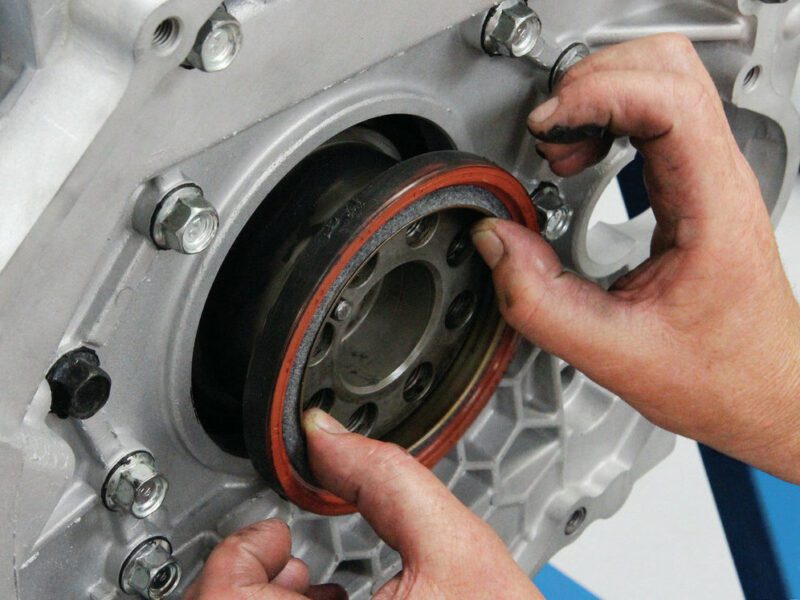
Замена переднего и заднего сальника коленчатого вала
Содержание
В процессе эксплуатации, автомобильный двигатель терпит различные нагрузки с постоянной переменчивостью режимов работы. Для обеспечения работоспособности двигателей внутреннего сгорания, значительного сокращения трения, износа деталей, а также во избежание перегрева, используется специальное моторное масло. Масло в моторе подается под давлением, самотеком и разбрызгиванием. Резонный вопрос — как обеспечить герметичность двигателя, чтобы масло не вытекло из него? Для этого существуют сальники, установленные, в первую очередь, спереди и сзади коленчатого вала.
В статье рассмотрим конструктивные особенности сальников коленвала, определим причины и характеристики их износа, а также разберемся с тем, как заменить эти сальники самостоятельно.
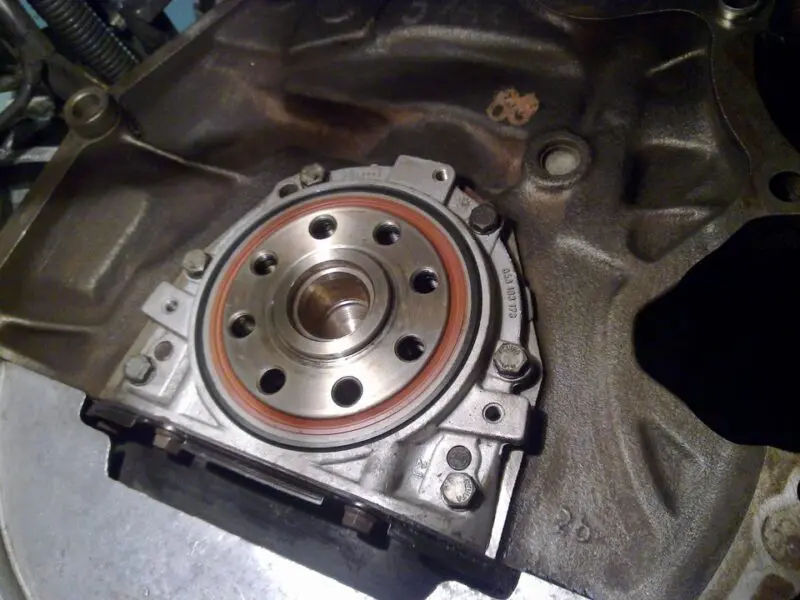
Описание и функции сальника коленвала
Итак, для нормального функционирования автомобильного двигателя, нужна качественная и постоянная смазка трущихся деталей. Один из главных элементов мотора — коленчатый вал, оба конца которого выступают наружу. Коленчатый вал смазывается под высоким давлением, а значит необходимо качественное уплотнение с двух сторон. В качестве этих уплотнителей выступают сальники. Всего используется два сальника:
- передний, обычно меньший в размере, устанавливается за шкивом коленчатого вала в передней крышке. Может быть интегрирован в масляный насос;
- задний, как правило, большой. Находится за маховиком, иногда меняется вместе с алюминиевой крышкой, обеспечивает герметичность, не пропуская масло в картер сцепления или коробки передач.
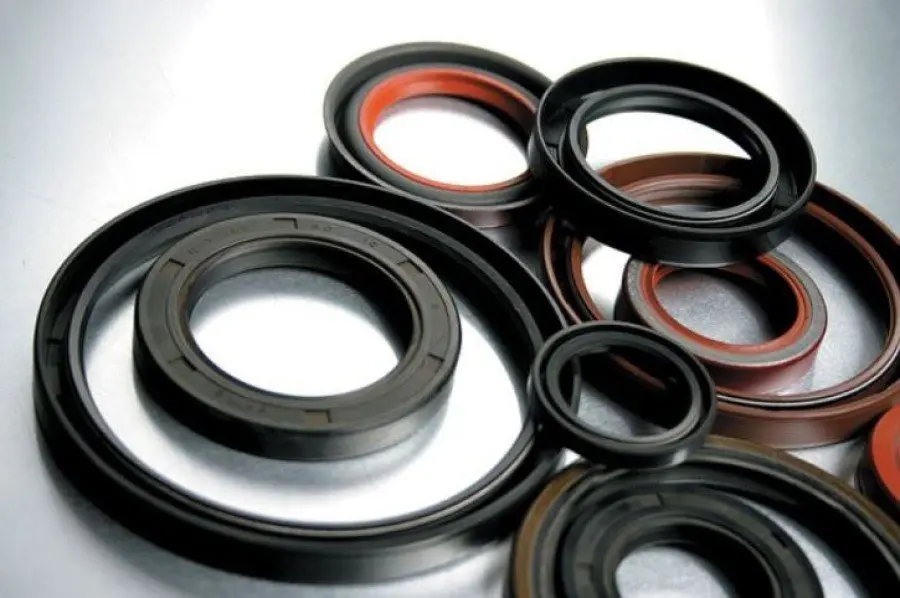
Как выглядит и где установлен
В качестве материала изготовления применяется фторкаучук или силикон. Раньше, в качестве заднего сальника использовалась сальниковая набивка, однако она имеет способность пропускать масло при работе двигателя на высоких оборотах. Форма сальников круглая, а вышеуказанные материалы, из которых они изготовлены, позволяют не терять эластичность в широком диапазоне температур. Диаметр сальника должен быть таким, чтобы со всех сторон плотно прилегал к поверхностям.
Также, сальники могут устанавливаться на распределительные валы, если таковые приводятся в движение посредством ремня. Обычно сальник распредвала имеет одинаковый размер с передним сальником коленчатого вала.
Немаловажно, при покупке новых сальников, выбирать качественных производителей, а также соблюдать следующие моменты:
- наличие пружинки внутри сальника;
- на кромке должны быть насечки, они называются “маслосгонными”, а также защищают от попадания пыли на ту самую кромку;
- насечки на сальнике должны быть направлены в сторону вращения вала.
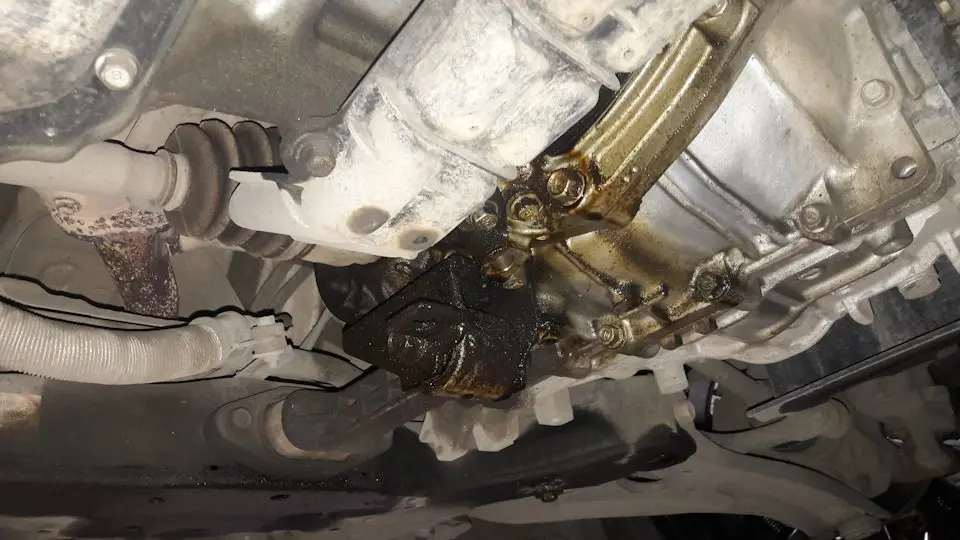
Износ сальника коленвала: причины и последствия
Согласно регламенту, средний срок службы сальников — около 100 000 километров, при условии, что авто эксплуатировался в нормальных режимах, а также своевременно проходит ТО, и двигатель не работал при критической температуре.
Каковы причины неисправности сальника:
- повреждение сальника из-за несвоевременной замены масла или попадания инородных мелких частиц, которые транспортируются маслом, повредили поверхность сальника;
- перегрев двигателя или долгая работа его в около критической температуре. Здесь сальник начинает потихоньку “дубеть”, а при понижении температуры теряет эластичность, масло начинает подтекать;
- некачественное изделие. Зачастую это связано с качеством материала, применением слабой пружинки, неправильно нанесенными насечками и деформированной формы самого сальника, который не обегает фланец коленчатого вала;
- из-за повышенного давление в системе смазки (большое количество картерных газов), а также чрезмерно высокий уровень масла выдавливает сальники, так как маслу более некуда деваться, и давлением выходит в самом уязвимом месте, но если сальники качественные, то масло может выходить из прокладок;
- неправильный монтаж нового сальника. Перед монтажом необходимо ознакомиться с инструкцией по установке, чтобы внутренняя часть сальника не закусилась. Кстати, существуют тефлоновые сальники, установка которых требует необходимых навыков и специнструмента, но об этом далее.
Главное последствие износа сальника коленвала — снижение уровня масла. Если сальник только потеет, то вы можете эксплуатировать автомобиль какое-то время, в другом случае необходима срочная замена сальника. Помимо того, что недостаточный уровень масла напрямую вредит ему и снижает ресурс трущихся поверхностей деталей, масло загрязняет подкапотное пространство, повреждает сервисный и ремень ГРМ, что может привести к серьезным последствиям.
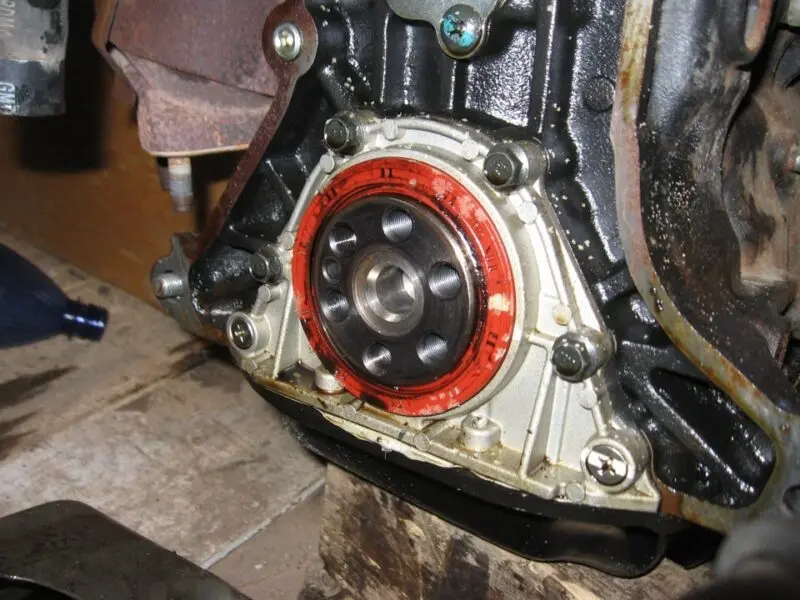
Диагностика утечки масла через сальники коленвала
Некоторые двигатели уже с первых километром потребляют некоторое количество масла, заложенное регламентом заводом-изготовителем. Спустя 100 000 километров расход масла повышается до 1 литра на 10000 км, что также считается нормой.
Первым делом, производится диагностика в виде поверхностного осмотра двигателя на предмет течи, если уровень масла подозрительно резко снижается. При работе мотора обращаем внимание на цвет выхлопа, если он не сизый, глушим мотор, открывает крышк радиатора или расширтельного бачка, и берем на пробу охлаждающую жидкость. Если антифриз пахнет маслом, а также присутствует масляная эмульсия — скорее изношена прокладка ГБЦ.
При отсутствии видимых причин расхода масла, поднимаем автомобиль на подъемник и осматриваем его спереди и сзади. Подтекание масла из-под сальников дает о себе знать течью из передней крышки, а также наличием масляных пятен на деталях подвески, так как масло, попадая на ремень — разбрызгивается. Износ заднего сальника диагностировать сложнее, так как в этой области находится сальник первичного вала КПП. Определить подтекание определенного уплотнителя можно на нюх, ведь моторное и трансмиссионное масло резко отличаются по запаху (второе пахнет чесноком).
Если нет возможности определить область подтекания, следует вымыть мотор, проехать некоторое количество километров и снова осмотреть агрегат в области уплотнителей.
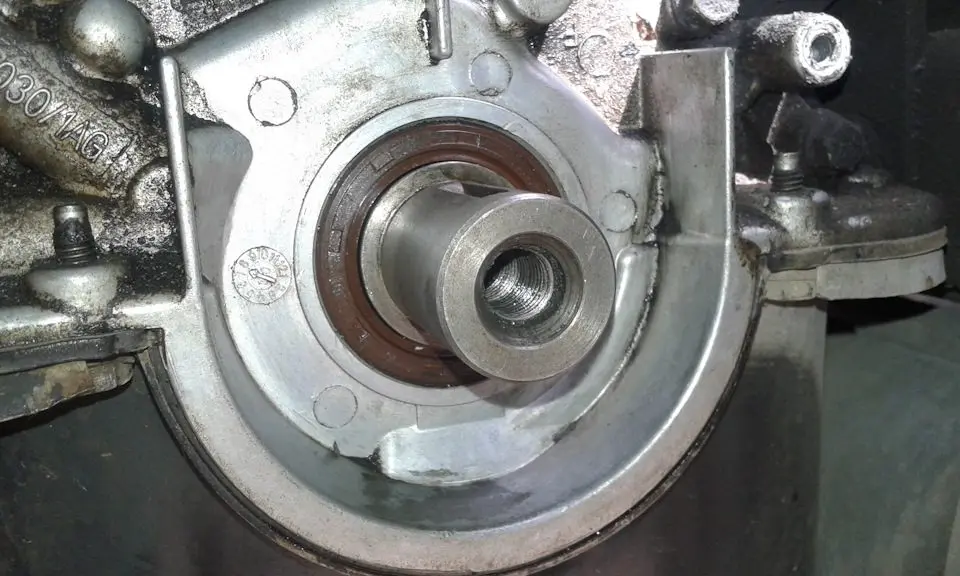
Замена переднего сальника + Видео
Для замены переднего сальника коленвала необходимо запастись минимальным набором инструментов, чистой ветошью, обезжиривателем (можно очиститель карбюратора). В зависимости от конструктивных особенностей двигателя, процесс замены сальника может отличаться. Для нашего примера возьмем среднестатистический автомобиль с поперечно расположенным мотором.
Поэтапный процесс снятия переднего сальника:
- перевести рычаг 5 передачу и поставить автомобиль на ручной тормоз;
- перед тем, как снять правое колесо, или поднять авто на подъемнике, необходимо попросить помощника нажать на тормоз, пока вы сорвете гайку крепления шкива коленчатого вала;
- снимаем колесо, открыв доступ к шкиву;
- в зависимости от типа натяжения сервисного ремня, необходимо его снять (посредством отведения натяжного устройства или ослабив крепление генератора);
- если двигатель имеет ременной привод ГРМ, вам необходимо демонтировать зубчатую шестерню коленвала;
- на носке коленчатого вала, как правило, находится шпонка, которая помешает при демонтажно-монтажных работах. Вынуть ее можно при помощи щипцов или плоскогубцев;
- теперь, когда сальник перед вами, необходимо очистить поверхность коленвала специальным спреем, а также ветошью очистить все грязные и замасленные места;
- с помощью отвертки поддеваем сальник и снимаем его, после спреем-очистителем обрабатываем посадочное место;
- если у нас обычный сальник, то рабочую поверхность смазываем моторным маслом, и насаживаем новый сальник, а в качестве обоймы можно использовать старый сальник;
- новая деталь должна входить плотно, обязательно следите, чтобы внутренняя часть (кромка) не завернулась, после установки сальник не должен выступать за пределы плоскости передней крышки мотора;
- далее сборка производится в обратной последовательности, после необходимо вывести уровень масла до нормы и запустить мотор, спустя некоторые время проверить герметичность.
Для полного понимания процесса замены переднего сальника коленчатого вала, рекомендую ознакомиться со следующим видеоматериалом.
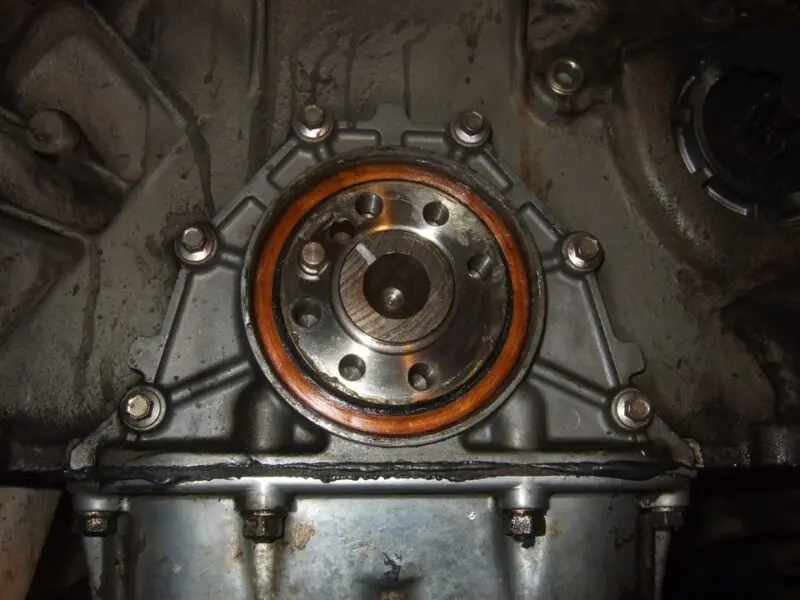
Замена заднего сальника + Видео
В отличие от замены переднего, замена заднего сальника — более трудоемкий процесс Это обусловлено тем, что для этого потребуется демонтаж коробки передач, сцепления и маховика. Настоятельно рекомендую сразу приобрести сальник первичного вала, чтобы в будущем не снимать КПП специально для замены такового.
Процесс замены коренного сальника коленвала:
- подготавливаем необходимый инструмент, скидываем отрицательную клемму с АКБ и готовимся к демонтажу коробки передач;
- отсоединяем механизм выбора передач или рабочий тормозной цилиндр от корпуса КПП;
- срываем ступичную гайку колеса, поднимаем автомобиль на подъемнике, или если вы на яме, то поднимаем необходимую сторону и снимаем переднее левое колесо;
- откручиваем ступичную гайку, после отсоединяем шаровую опору рычага, и отводим поворотный кулак в сторону так, чтобы высвободить из него полуось;
- демонтаж полуоси производится методом выдергивания его из коробки передач;
- убедившись, что все датчики и остальное навесное оборудование отсоединено от коробки передач, приступайте к отсоединению трансмиссии от силового агрегата;
- открутив все болты коробки передач от двигателя (не менее 10), при помощи монтировки поддеваем КПП и вытягиваем его из посадочного места. Для этого потребуется минимум один помощник, потому как вес коробки передач минимум 30 килограмм;
- после снятия КПП сделайте акцент на состояние сальника первичного вала, и желательно замените его, даже если нет признаков его запотевания, но пробег авто преодолел отметку 100 000 километров;
- далее необходимо снять корзину и диск сцепления, которые крепятся 6 болтами к маховику;
- после демонтажа пакета сцепления, перед нами появляется маховик, который также крепится к фланцу коленчатого вала шестью усиленными болтами, и для откручивания их, необходимо зафиксировать маховик во избежание проворачивания;
- открутив маховик добираемся до заднего сальника коленчатого вала. В зависимости от конструкции, он меняется как отдельная запчасть, или вместе с металлическим фланцем. Производим аналогичные мероприятия по очистке посадочного места, снимаем сальник аналогично переднему и устанавливаем новый в такому же принципу;
- далее монтаж производится в обратном порядке.
Для более ясного понимания замены заднего сальника коленвала — ознакомьтесь с данным видеоматериалом.
Особенности замены тефлонового сальника коленчатого вала
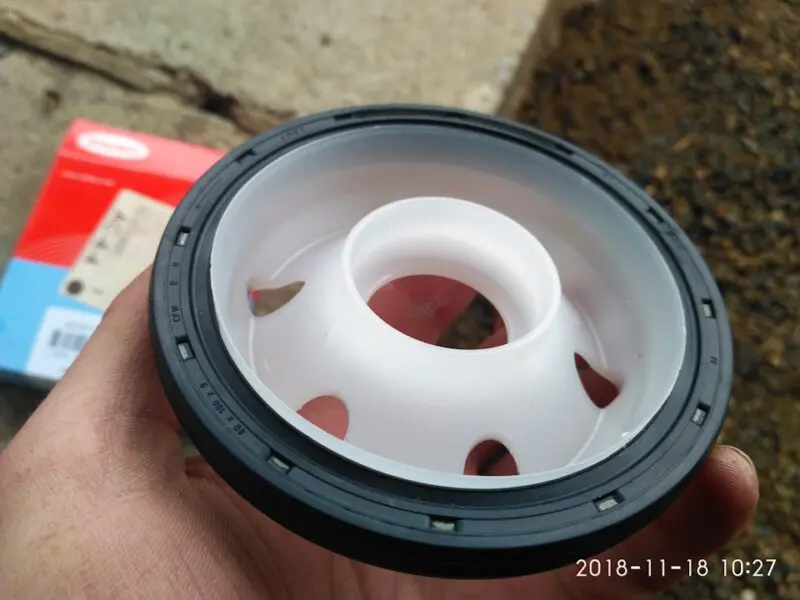
Помимо обычных фторкаучуковых сальников существуют аналоги, стоимость которых превышает в 1.5-2 раза — сальники с тефлоном кольцом. Особенность установки такого сальника заключается в том, что монтаж его производится исключительно на очищенную поверхность и при помощи специальной осадочной оправки. После установки нужно подождать 4 часа, за это время сальник самостоятельно “сядет” на свое место, главное за это время не вращать коленвал.
Когда менять сальники
Замена сальников производится в трех случаях:
- сильный перегрев мотора;
- обильное подтекание масла и-под сальников;
- при капитальном ремонте ДВС.
Крайне важно приобретать качественные сальники. Говоря о переднем сальнике, то можно применять такие аналоги, как Elring и Glaser, ведь в случае чего их заменить проще. Задний сальник, желательно приобретать оригинального производства, однако высокая цена заставляет автолюбителей останавливать выбор на аналоге, что вскоре может обернуться внеплановой заменой коренного сальника.
Подведем итоги
Итак, сальники коленчатого вала — ответственные детали, которые обеспечивают герметичность смазочной системы и защищают от пыли фланцы коленвала. Крайне важно не пропустить момент утечки масла из-под сальников, чтобы двигатель не повредился от недостаточного уровня масла. Достаточно каждое ТО зрительно осматривать двигатель на предмет течей масла и охлаждающей жидкости, чтобы всегда быть уверенным в своем автомобиле.
Вопросы и ответы:
Когда менять передний сальник коленвала? Средний рабочий ресурс сальников коленчатого вала составляет около трех лет или когда пробег автомобиля достигает 100-150тысяч километров. Если они не потекли, их все равно рекомендуется заменить.
Где находится сальник коленвала передний? Это уплотнитель коленчатого вала, предотвращающий утечку масла. Передний сальник находится на шкиве коленвала со стороны генератора и ремня ГРМ.
Почему течет передний сальник коленвала? В первую очередь из-за естественного износа. Длительный простой, особенно на улице зимой. Заводской брак. Неправильная установка. Чрезмерное давление картерных газов.

